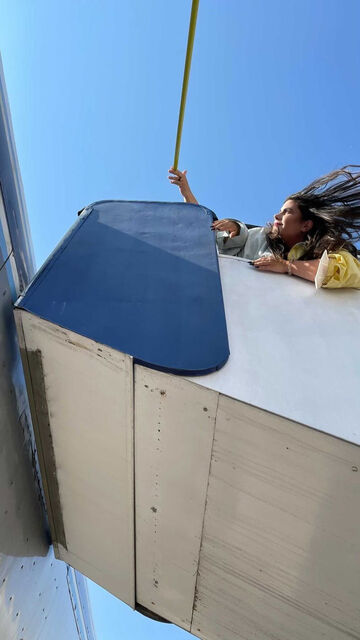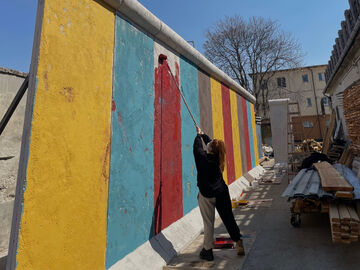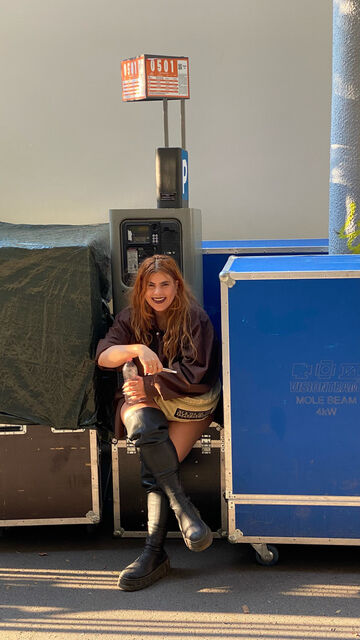Creation of Worlds - Interview Réka Hársfalvi, Set Designer and Art Director
Interview Réka Hársfalvi, Production Designer and Art Director
Jul 12, 2023
With a mischievous spirit and an insatiable love for aesthetics, Réka's passion for crafting immersive visual experiences shines through. From her early years as a curious schoolgirl to her remarkable adventures on film sets across the globe, get ready to dive into a world where colors, textures, and meticulous attention to detail converge.
"I remember being a pretty mischievous girl, although I did well in important things and brought home good grades from school. But as it usually goes, my behavior caused some problems. I loved to chit-chat, but I don't think it's a bad thing if a child enjoys misbehaving," summarizes Réka Hársfalvi, a set designer and art director, with a smile, her years in elementary school in the late '90s.
Like many girls of that time, she loved trying out many things and being involved in everything, but she also quickly found joy in quietly observing her surroundings. "I wasn't conscious at all, I just started feeling drawn to visuals. I loved and still love looking at anything beautiful or interesting, anything that captivates me."
Middle school was followed by high School, and everyday life in Budafok (a small town on the outskirts of Budapest) was replaced by Budapest (the Hungarian capital), and in Réka's mind, the desire to continue studying in the field of art became more and more crystallized. Her parents always supported her and created the opportunity for her to pursue what she loved the most. That's how she started attending preparatory courses with painter Rita Kopek and took her first steps towards her current profession. She applied to the textile department at MOME (Moholy-Nagy University of Art and Design) and was accepted on her second attempt, successfully completing her university studies. "I loved the first year; I felt like I had finally found my environment. In the second and third years - but I think this is natural - my enthusiasm waned a bit. I also started getting interested in things outside of university. We had our own attempts; we created clothing brands, and that's when I started working as a stylist in music videos. After completing my undergraduate studies, I also enrolled in the master's program, but I dropped out very quickly."
The Indian Episode
It happened because of a life-changing phone call. She was invited to work on costume design for an Indian film shoot. She accepted the job and fell in love with the world of filmmaking during the shoot. Just like at art school, Réka felt that she had found her place. It quickly became apparent that she wanted to see more of this world. "The madness that was happening in the art department immediately drew me in." And as it usually happens, she had a friend who worked at a production company, and that's how Réka joined Prop Club, which works on numerous domestic and international productions. "I primarily socialized in service jobs; we worked on both commercials and feature films. It was here that I learned about the structure of the art department, the different positions and who works under whom." Then, when the basics were already in place, she started working alongside production designer Petra Vinnai. "From the beginning, there was chemistry between us, and we worked very well together. At first, I was a production designer assistant next to her or next to the art director. Then, when she became the production designer for 'A Játszma' (The Game), I became an art director for the first time." Which means that Réka became the right-hand person of the production designer. She is the one who brings to life everything that the production designer envisioned, working with the props & construction teams, who provide furniture and props, and even those who plant the plants on the set.

Behind the Words
One might wonder if there will come a moment when Réka will search for something new again. We cannot know that in advance, but one thing is certain: for quite some time now, she has felt at the right place, working not only as an art director but also as a set designer. "Colors, shapes, different materials - I found everything here that made me apply to art school. The task is complex, and that's why it suits me so well: it covers everything from building huge backgrounds to sourcing the smallest props visible in the foreground. To this day, I am fascinated when trucks arrive, and we build these massive sets." But it is also necessary to breathe life into the sets, and this is another important aspect of the art director's work: creating the atmosphere and shading the characters' personalities. "The space or background we build for a particular scene or commercial already gives the viewer a feeling before anything happens. And this is how we contribute to character portrayal: when you enter a character's room or their space in a film, whether it's a feature film or a commercial, it works well if it is expressive. A messy room or a meticulously arranged living space, along with the colors, all help to further immerse the audience in the story and get to know the characters better."
However, the tasks are not only diverse within a single film, but the productions themselves are always different. After a service film, there might be a Hungarian feature film, and even a commercial can fit in between. "I have worked on big productions as well as small-budget Hungarian films, both domestic and international commercials. These experiences have been very educational for me; each one is different, but it's also excellent practice to gain a deeper understanding of a production and be able to respond quickly to the challenges that arise."

The Power of Magic
The challenges can vary greatly, and we, as viewers, may not realize how important even the tiniest and seemingly insignificant details are to a set designer. Recently, as a set designer for a documentary drama set in Shakespeare's time, her research work is a good example of this. "At first, I was very afraid of this type of film because I was never interested in history at school; I can't even remember a single date. I thought it would be difficult for me to connect, but somehow it drew me in. I started enjoying it a lot when I could immerse myself in a particular historical period and find those tiny details that authenticate a scene. Thank God, in these kinds of productions, there are historical experts who help and whom you can call with the most foolish questions. For example, whether they used toilet paper in 1800, and if not, what can we use instead in the set. Recently, I had questions about fruits. The story was set in late 1500s and early 1600s London. I read somewhere that pineapples had already started to appear back then, which is a fruit with a great shape and color, and I wanted to put one or two in the set. My colleagues in London confirmed what I had read, but they suggested avoiding its use because pineapples were not eaten back then; they were used only as decorations, and even then, very rarely. These seemingly trivial things are extremely important. Most viewers probably wouldn't even notice my pineapple, but if there are three people who do, then we would shatter their movie experience. From that point on, they won't be able to immerse themselves, they will be thrown off, and the magic will be lost."
